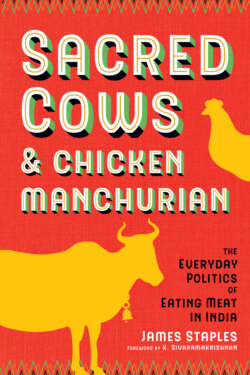Sacred Cows and Chicken Manchurian

Реклама. ООО «ЛитРес», ИНН: 7719571260.
Оглавление
James Staples. Sacred Cows and Chicken Manchurian
CONTENTS
FOREWORD
ACKNOWLEDGMENTS
Introduction
A DEVELOPING INTEREST IN BEEF AND COW POLITICS
COW POLITICS IN CONTEMPORARY INDIA
PLACES AND PEOPLE
METHODS AND ETHICS
THE ANTHROPOLOGY OF FOOD AND EATING IN INDIA
MATERIAL SYMBOLS
TWO RECURRING ISSUES
Vegetarian Dilemmas
Of Cows and Buffaloes
CHAPTER ONE. Differential Histories of Meat Eating in India
REIMAGINING THE PAST IN THE PRESENT
VEDIC REFERENCES TO CASTE AND FOOD
CATTLE IN COLONIAL TIMES
BOVINE POLITICS IN POSTINDEPENDENCE INDIA
CONCLUSION: COMPLEX HISTORIES
CHAPTER TWO. Everyday South Indian Foodways
EVERYDAY DINING IN COASTAL ANDHRA
Morning: Tea, Milk, Breakfast, and Snacks
Afternoon: Lunch and Snacks
Evening: Dinner
Meat Eating
Alcohol
FOOD IN THE CITY
DECIPHERING ANDHRA CUISINE
CONCLUSION: MATERIAL SYMBOLS
CHAPTER THREE. From Cattle Shed to Dinner Plate
TAKING ON SACRED COWS
THE BEEF CHAIN
From Cattle Purchase to Slaughter
Beef Sellers
Beef Buyers
OF KNOWING AND NOT KNOWING
CONCLUSION: CIRCUMVENTION AND COMPLICITY
CHAPTER FOUR. Cattle Slaughter, Beef Eating, and Ambivalence
CHARTING CHANGING ATTITUDES
Other Kinds of Meat
Beef Distinctions
Surreptitious Meat Consumption
AMBIVALENT ATTITUDES TOWARD COWS AND BEEF
CONCLUSION
CHAPTER FIVE. Health, the Environment, and the Rise of the Chicken
RECENT CHANGES IN MEAT-EATING PRACTICES
DECLINE OF THE GOAT
RISE OF THE CHICKEN
Local Change and Chicken
Chicken after the Green Revolution
Promoting the Broiler
Global Chickens: The US Influence
Sanitizing the Chicken
MEAT AND HEALTH
MEAT AND THE ENVIRONMENT
CONCLUSION: CHANGING MEAT-EATING PRACTICES
CHAPTER SIX. From Caste to Class in Food
CLASS IN SOUTH INDIA
FEEDING GUESTS IN ANANDAPURAM
Lunch at Babu’s
Dinner at Sarojini’s
Remembering Past Repasts
Interpreting Anandapuram Dining
MEAT, CLASS, AND CASTE
Kotaiah: High-Caste Meat Eating and Urban Success
Prakash: Lower-Caste Beef Avoidance
Chic Meat versus Dalit Consumption
CONCLUSION: SOCIAL DIFFERENTIATION THROUGH FOOD
Conclusion
BOVINE ASSUMPTIONS
CONTESTED HISTORIES
SUSTAINING “SACRED COW” NARRATIVES IN THE PRESENT
Globalization and Economic Liberalization
Resisting “the Other”
Liberal Silences and Converging Forces
MEAT CONSUMPTION IN CONTEXT
THE CASE FOR ETHNOGRAPHY
High-Caste Complicity in the Beef Business
Complexities of Human-Cattle Relations
Distinctions between Vegetarianism and Nonvegetarianism
Beyond Nationalism
Meat and Class Distinction
BUSTING DICHOTOMIES
The Material and the Symbolic
The Trouble with “Culture”
Complicating Binaries
LAST WORDS
GLOSSARY. ABBREVIATIONS
NOTES. INTRODUCTION
CHAPTER ONE: DIFFERENTIAL HISTORIES OF MEAT EATING IN INDIA
CHAPTER TWO: EVERYDAY SOUTH INDIAN FOODWAYS
CHAPTER THREE: FROM CATTLE SHED TO DINNER PLATE
CHAPTER FOUR: CATTLE SLAUGHTER, BEEF EATING, AND AMBIVALENCE
CHAPTER FIVE: HEALTH, THE ENVIRONMENT, AND THE RISE OF THE CHICKEN
CHAPTER SIX: FROM CASTE TO CLASS IN FOOD
CONCLUSION
REFERENCES
INDEX
Отрывок из книги
CULTURE, PLACE, AND NATURE
Studies in Anthropology and Environment
.....
With the help of Das, my research assistant, in 2016 and 2017 we also met butchers, brokers, and others for whom beef was an integral part of their everyday lives (even when, as was sometimes the case for the brokers, they did not eat it themselves). Through our beef-seller contacts, we also attended cattle markets, long bus rides away, in order to trace the journeys cattle took from the cowshed to the serving dish, and to tease out how what the animals meant or represented changed along the way. In the same way that other commodities are transformed by, or transformative of, the contexts through which they pass, so too are cattle and the other parties involved changed along the way.16
Taken together, these diverse settings, emerging as they did out of serendipity as much as preplanning, offered windows onto a unique range of everyday perspectives on cattle, on beef, and on food and eating more generally. Although some of those we worked with, such as the meat sellers, had a vested interest in keeping up to date with stories of vigilante attacks and government action on cattle slaughter, for the most part my interlocutors would not describe themselves as activists. We did not seek to work with those directly engaged in perpetrating violence against those who traded in beef, nor did we spend time with those who organized beef festivals or other events aimed at defending the gastronomic rights of those who wished to eat meat derived from cattle. There is, to be sure, important ethnographic work to be done with these groups, and there are interesting questions to be asked about their respective roles in contemporary democracy and the Indian state. The perspectives of both, however, have been well reported upon (and sometimes, perhaps, caricatured) in the press and in social media, occasionally represented more directly through blogs and YouTube videos. Although I have read and watched a great deal of this material, my interest has been to give greater weight to the voices of those not only less heard but also more widespread, and to interpret what they said in the richly layered contexts in which they were embedded. These were the voices of those who chose to eat or not eat beef but who, most of the time, took more ambivalent, more nuanced positions on the issues than those on either side of the debate as it was represented in everyday discourse. I regard those voices not as fixed but as shifting in tune with the world around them. Such people are not easily pigeonholed, either by caste or by community or even within the new classifications that have arisen out of more recent work that interrogates class.17
.....